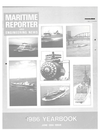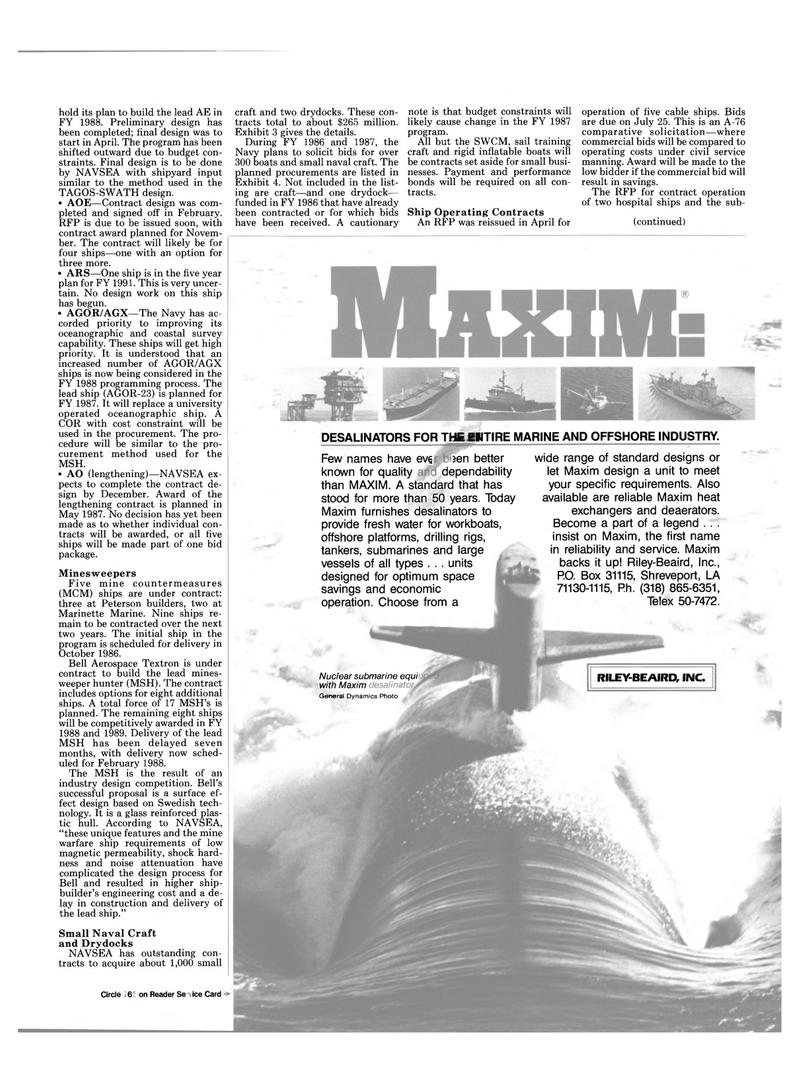
Page 33: of Maritime Reporter Magazine (June 1986)
Read this page in Pdf, Flash or Html5 edition of June 1986 Maritime Reporter Magazine
hold its plan to build the lead AE in
FY 1988. Preliminary design has been completed; final design was to start in April. The program has been shifted outward due to budget con- straints. Final design is to be done by NAVSEA with shipyard input similar to the method used in the
TAGOS-SWATH design. • AOE—Contract design was com- pleted and signed off in February.
RFP is due to be issued soon, with contract award planned for Novem- ber. The contract will likely be for four ships—one with an option for three more. • ARS—One ship is in the five year plan for FY 1991. This is very uncer- tain. No design work on this ship has begun. • AGOR/AGX—The Navy has ac- corded priority to improving its oceanographic and coastal survey capability. These ships will get high priority. It is understood that an increased number of AGOR/AGX ships is now being considered in the
FY 1988 programming process. The lead ship (AGOR-23) is planned for
FY 1987. It will replace a university operated oceanographic ship. A
COR with cost constraint will be used in the procurement. The pro- cedure will be similar to the pro- curement method used for the
MSH. • AO (lengthening)—NAVSEA ex- pects to complete the contract de- sign by December. Award of the lengthening contract is planned in
May 1987. No decision has yet been made as to whether individual con- tracts will be awarded, or all five ships will be made part of one bid package.
Minesweepers
Five mine countermeasures (MCM) ships are under contract: three at Peterson builders, two at
Marinette Marine. Nine ships re- main to be contracted over the next two years. The initial ship in the program is scheduled for delivery in
October 1986.
Bell Aerospace Textron is under contract to build the lead mines- weeper hunter (MSH). The contract includes options for eight additional ships. A total force of 17 MSH's is planned. The remaining eight ships will be competitively awarded in FY 1988 and 1989. Delivery of the lead
MSH has been delayed seven months, with delivery now sched- uled for February 1988.
The MSH is the result of an industry design competition. Bell's successful proposal is a surface ef- fect design based on Swedish tech- nology. It is a glass reinforced plas- tic hull. According to NAVSEA, "these unique features and the mine warfare ship requirements of low magnetic permeability, shock hard- ness and noise attenuation have complicated the design process for
Bell and resulted in higher ship- builder's engineering cost and a de- lay in construction and delivery of the lead ship."
Small Naval Craft and Drydocks
NAVSEA has outstanding con- tracts to acquire about 1,000 small craft and two drydocks. These con- tracts total to about $265 million.
Exhibit 3 gives the details.
During FY 1986 and 1987, the
Navy plans to solicit bids for over 300 boats and small naval craft. The planned procurements are listed in
Exhibit 4. Not included in the list- ing are craft—and one drydock— funded in FY 1986 that have already been contracted or for which bids have been received. A cautionary note is that budget constraints will likely cause change in the FY 1987 program.
All but the SWCM, sail training craft and rigid inflatable boats will be contracts set aside for small busi- nesses. Payment and performance bonds will be required on all con- tracts.
Ship Operating Contracts
An RFP was reissued in April for operation of five cable ships. Bids are due on July 25. This is an A-76 comparative solicitation—where commercial bids will be compared to operating costs under civil service manning. Award will be made to the low bidder if the commercial bid will result in savings.
The RFP for contract operation of two hospital ships and the sub- continued)
Circle 168 on Reader Sen/ice Card-*
RILEY-BEAIRD, INC.
General Dynamics Photo
DESALINATORS FOR ThM ENTIRE MARINE AND OFFSHORE INDUSTRY. ?en better dependability
Few names have eve known for quality than MAXIM. A standard that has stood for more than 50 years. Today
Maxim furnishes desalinators to provide fresh water for workboats, offshore platforms, drilling rigs, tankers, submarines and large vessels of all types . . . units designed for optimum space savings and economic operation. Choose from a wide range of standard designs or let Maxim design a unit to meet your specific requirements. Also available are reliable Maxim heat exchangers and deaerators.
Become a part of a legend . . . insist on Maxim, the first name in reliability and service. Maxim backs it up! Riley-Beaird, Inc.,
P.O. Box 31115, Shreveport, LA 71130-1115, Ph. (318) 865-6351,
Telex 50-7472.
Nuclear submarine equi with Maxim

 32
32

 34
34
